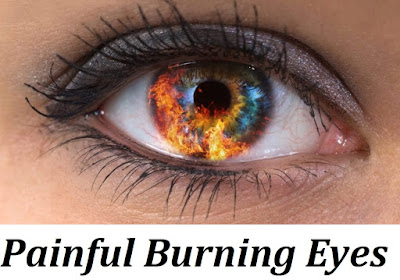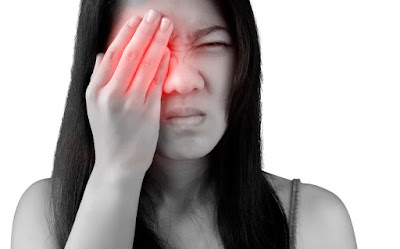In this way
you can prevent dry eyes or visual stress.
Our eyes have never been so
challenged as they are today. Staring at computer screens, smartphones, etc.
for hours quickly tires your eyes and can lead to dry eyes, burning eyes,
reddened eyes, and even headaches, neck pain, and back pain. In our modern lifestyle,
we rarely look into the distance, blink less and often eat at high speed. Did
you know that myopia (short-sightedness) appears to be associated with intense
near work? This is the subject of science and research worldwide.
Read what you
can do for healthy eyes.
Our 10 tips for your eye health, for relaxed vision at
any age.
Tip 1: Blink.
We now know that dry eyes are also caused by too little blinking, or more precisely, insufficient blinking. Many hours of the day we look at a screen or display. There is usually a lot of focus on being tired. We blink very little to constantly wet the cornea of the eye with tear fluid and thus prevent it from drying out. Actually, blinking is automatic, like breathing. A person closes and opens their eyelids briefly and reflexively about 10 to 15 times per minute. When working on a screen or reading, we unconsciously forget to blink enough due to strong concentration. We literally suppress it. Eyes begin to dry within minutes. The wafer-thin tear film on the eye becomes uneven until it eventually breaks. Vision then blurs to blur. Our body tries to compensate for poor vision. It not only causes eye strain but also fatigue and headache. The following applies: Consciously blink regularly by closing and opening your eyelids briefly and tightly. It also stimulates the so-called meibomian glands at the edge of the eyelids. The meibomian glands secrete an oily fluid that mixes with the tear fluid secreted by the lacrimal glands, preventing the latter from evaporating too quickly.

Tip 2: Plan to take breaks.
The 20/20/20 rule is a very good gauge for seeing
sufficiently far into the distance. Look about 20 meters away for 20
seconds about every 20 minutes. You can also practice this wonderfully during
work. This is how you can prevent digital visual stress. Just pretend to
think...
Tip 3: Air your eyes.
Like our whole organism, our eyes also need fresh air. A
walk helps and can relax overtired eyes. Especially in the cold season, many
rooms are overheated and there is not enough humidity. If you then sit in front
of the screen or display for a particularly long time, you shouldn't forget to
air it out. For higher humidity in rooms, it also helps to set up bowls of
water or put damp cloths on heaters.
Tip 4: Eyes love green (stuff).
It used to be that eating carrots is good for your eyes. At that time it was assumed that the macula pigment, ie the pigment that is found in a high proportion in the macula – the point of sharpest vision on the retina – consists of beta-carotene. Today we are one step further. It has now been researched that the pigment consists of lutein and zeaxanthin. Consuming these two substances can help prevent age-related macular degeneration. The foods richest in lutein are kale, spinach, broccoli, arugula, and cabbage — green vegetables. However, it is also known that lutein and zeaxanthin are derivatives of beta-carotene. So eating carrots is also good for our eyes. A healthy and balanced diet is generally important for vision and for the whole organism.
Tip 5: Drink water and get enough sleep.
Drinking enough is very important for dry eyes. Two to three liters of water or unsweetened tea daily ensure that the eyes remain sufficiently moistened. Sufficient sleep also allows the eyes to regenerate. Seven to eight hours a night is ideal. This is pure wellness for eyes plagued by visual stress. Important: Avoid exposure to blue light from displays before bed. Blue light signals your body and eyes: "Stay awake". How about romantic candlelight again? Light has a proven and significant influence as a supporting clock on our sleep-wake cycle. The endogenous hormone melatonin, also known as the sleep hormone, plays an important role here. In the case of intensive exposure to blue light, special receptors in the eye mediate a reduced release of melatonin. The feeling of onset of tiredness is absent or at least delayed. On the other hand, an increase in melatonin release when there is little blue light enables the body to find its way into the important sleep via the actually perceived tiredness.
 |
| Water and Sleep for Eye Health |
Tip 6: No preservatives, please.
The following applies to cosmetics and eye drops: For the benefit of your eyes, only use the products in unpreserved form. Your optician, doctor or pharmacist can help you with the selection. Eye drops must be sterile to prevent eye infections. Therefore, eye drops that contain more than one dose and are once opened should never be used longer than the specified use-by date. Disposable eye drops are often the better solution. In general, sterility is only guaranteed for the period of use, so do not use eye drops after the expiry date to be on the safe side.
Tip 7: Massage for the eyes.
A targeted and careful eyelid massage is wonderful for keeping the eyelid glands fit. This supports the function of the eyelid glands for the adequate formation of the tear film, which prevents dry eyes.
Fitness for the eyelid glands, this is how it works:
- Warm the eyelids so that the viscous and thickened secretion in the meibomian glands is liquefied. This works with a washcloth soaked in warm water or a gel mask, which you can briefly warm up in a pot on the stove or oven (max. 60 degrees) over moderate heat. Put this on your eyes for 7-10 minutes and relax. Be sure to check the inside of your wrist before you put the mask on to make sure it is not too hot.
- Then comes the eyelid massage: With this gentle massage, you smooth out the liquefied secretions of the Meibomian glands. With your eyes closed, carefully use a finger to stroke the upper eyelid from top to bottom and the lower eyelid from bottom to top up to the eyelid gap. Lastly, from the outside in to the nose.
- After the massage, you should gently cleanse the eyelids (upper eyelid from top to bottom, lower eyelid from bottom to top to the gap between the eyelids) with a cotton pad soaked in eye cleansing liquid, working from the outside inwards with your eyes closed.
Tip 8: Please no drafts for your eyes.
Fresh air is good for the eyes, but please no drafts. So avoid direct drafts from air conditioning systems or fans in heavily air-conditioned interiors and also in the car. In this way you can prevent dry eyes and eye infections. It's better to open the window for a while now and then, or darken the room to protect against too much sunlight in midsummer.
Tip 9: First choice - UV protection.
Our eyes need UV protection just like our skin. UV light puts a considerable strain on our eyes. Not only on sunny days, but also on cloudy ones. UV radiation is always there. That is why many skin creams, not just special sunscreens, increasingly contain UV protection. It is less self-evident that the eyes also have to be protected from dangerous UV rays. Like the skin, the eyes can also suffer from sunburn or the retina can be permanently damaged. In the worst case, consequential damage such as cataracts or, years later, age-related macular degeneration can occur. Cancer on the edge of the lid and eye can also be a result of excessive exposure of the eyes to UV light.
Tip 10: Always the right glasses.
Enjoy life to the fullest. This also includes the best vision and a clear view. Have your vision checked regularly by an optician or ophthalmologist. Choose your glasses according to your vision needs. There are the right lenses for all requirements. For example, for driving, an optimal posture at work or for your favorite sport.







































